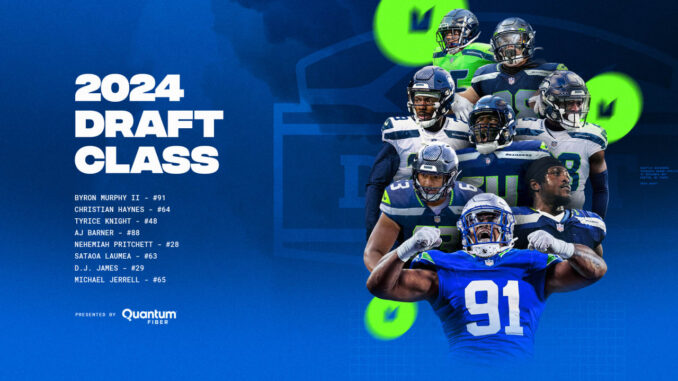
The Seattle Seahawks entered last weekend’s NFL draft with a mid-first-round pick and a checklist of needs.
They came out the other side of the draft with a franchise player in the middle of the defense, and most of their list was checked off.
It was one of the duller drafts in recent Seahawks history, executed with all the flair of a trip to the grocery store. Still, it set up the Seahawks for immediate success under new coach Mike Macdonald and longtime general manager John Schneider.
Coming into the draft, the Seahawks’ checklist included solidifying the defensive line, solidifying the offensive line, rebuilding the defensive secondary, and maybe finding their quarterback of the future. They came out of the draft with nearly every critical item checked.
The Seahawks, along with a ton of other teams, were attempting to find their quarterback of the future in this draft. The Seahawks reportedly inquired about moving up into the top ten to grab a quarterback but rightfully balked at the price. They will likely be better for it in the long run. No. 1 overall pick Caleb Williams of USC earned the right to become the latest quarterback to get ground down physically, emotionally, and spiritually by the Chicago Bears. Following that pick, many of the teams simply lost their minds. If you are capable of gripping a football, taking a three-step drop, and throwing it, you were probably picked in the top 15 picks of the draft. In a normal year, Michael Penix of Washington, Bo Nix of Oregon, and JJ McCarthy of Michigan probably have the ceiling of a second-round draft pick. This was not a normal year. All of them were off the board before the Seahawks even got to pick.
With most of the teams in front of them going coo-coo for quarterbacks, the Seahawks wisely stayed put and grabbed the best interior defender in the draft in Byron Murphy II at the No. 16 pick. He will be an unquestioned day-one starter for the Seahawks and provide an imposing presence in the middle of the defensive line. With their next pick, in the third round, the Seahawks grabbed another player who figures to be a day-one starter in offensive lineman Christian Hayes from UConn.
They found another probable starter in fourth-round tight end AJ Barner from Michigan. Barner will help in blocking upfront and figures to fill departed tight end Will Dissly’s shoes. Over the rest of the draft, the Seahawks focused on filling in a variety of other needs while focusing on the upside. Tyrice Knight, a linebacker from UTEP, along with cornerbacks Nehemiah Pritchet and D.J James from Auburn, both fit that mold. Both are raw talents who may eventually transition to safety to help the team bolster its depth at that position. The Seahawks also picked up guards Sataoa Laumea from Utah and Michael Jerel out of Finley.
Jerel, in particular, is an intriguing pick. At 6’5, 294, he’s tall and relatively thin for an offensive line prospect; he also came from an unheralded program and was projected to go undrafted potentially. However, without a seventh-round pick, the Seahawks grabbed him with their final pick in the draft. The team could have traded down out of the pick and likely picked up maybe a seventh-round pick, but then they would have gambled on potentially not getting the player they wanted, either because another team grabbed him before their new pick came up or because another team signed him as an undrafted free agent. It was the same strategy the Falcons went with in drafting Penix: Grab the player you want now instead of gambling that he could be available later. However, by using a sixth-round pick, instead of the No. 6 overall, on such a move, the Seahawks have much lower stakes if their bet doesn’t pan out.
Over the final decade of Pete Carroll’s tenure as coach, the Seahawks often experimented with the draft. After their heralded drafts of the early 2010s, the Seahawks turned to using their draft picks to trade for established players, such as Percy Harvin, Jimmy Graham, Jamal Adams, and Duane Brown, to keep the competitive window open. Once their core began aging out, the Seahawks often zigged when they projected to zag. Sometimes, that strategy netted them franchise centerpieces such as Devon Witherspoon. Other times, it netted them Rashaad Penny.
The first draft of the MacDonald era signaled a return to the early days of John Schneider’s tenure as GM—identifying a need, drafting the best players available, and plugging guys into their spots. While this draft class may not rival 2010 or 2012, it certainly goes a long way toward establishing the team’s new identity while filling some obvious gaps from last year.
Whether the return to non-nonsense drafting can return the team to a similar peak to its early 2010s draft remains to be seen, but the 2024 draft certainly seems to be setting the team up for another climb up the NFL ladder.




